LOCAL HISTORY: Russell Lord's daughter wed Pres. Harrison
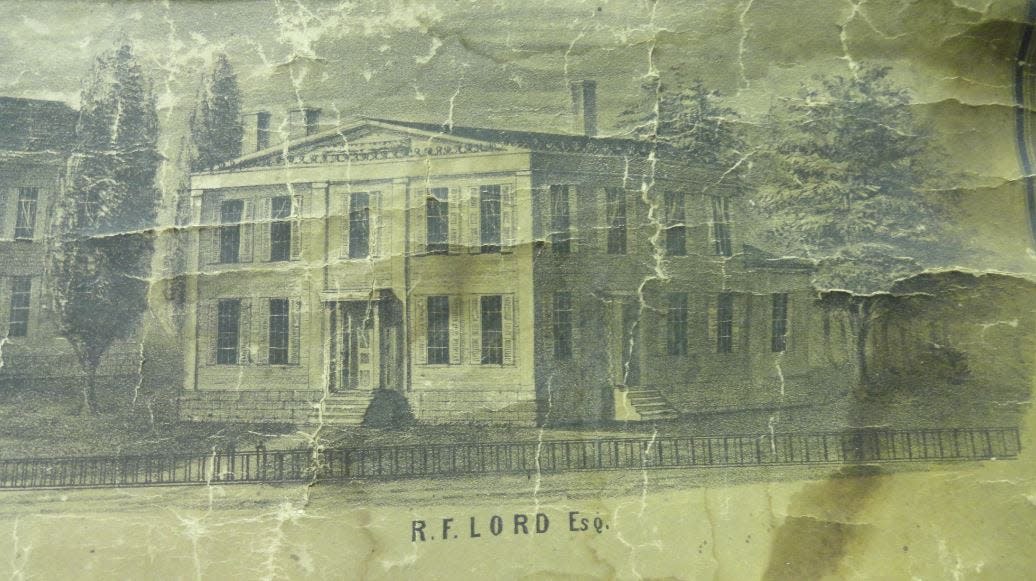
- Oops!Something went wrong.Please try again later.
- Oops!Something went wrong.Please try again later.
- Oops!Something went wrong.Please try again later.
HONESDALE - One of the citizens of influence in Honesdale, Pa.'s storied history was Russell F. Lord, Sr. (His first name is often spelled "Russel".) He was Chief Engineer of the Delaware & Hudson (D&H) Canal Company and was a major benefactor in the building of Temple Beth Israel in the 1850's.
He is perhaps best remembered, however, for his daughter Mary's marriage to President Benjamin Harrison, after leaving office.
As if this connection to a United States President was not remarkable enough, Harrison's first wife and serving as First Lady was Caroline Scott, an aunt to Mary. Before they were married, Caroline was on an extended visit to Honesdale, when the future President came calling on her.
Russell F. Lord
Russell Farnham Lord (Sr.) was born August 17, 1802 at Rome, NY, son of Zelotes Lord and Sarah Sallie (Farnham). He had two brothers, Solomon Z. (1799-1890) and John F. (1817-1902).
Honesdale was founded in the mid-1820's by the D&H Canal Company as the terminus of its grand canal that was then under construction.
He went to work for the D&H in 1826. He and another young engineer, James Archbald, were supervised by John B. Jervis, assistant to Chief Engineer Benjamin Wright. Jervis became Chief Engineer in 1830 and when he left the company the next year, Lord was promoted to Chief Engineer.
Archbald was appointed as superintendent of the gravity railroad and mining operations in the Carbondale area and down the Lackawanna Valley.
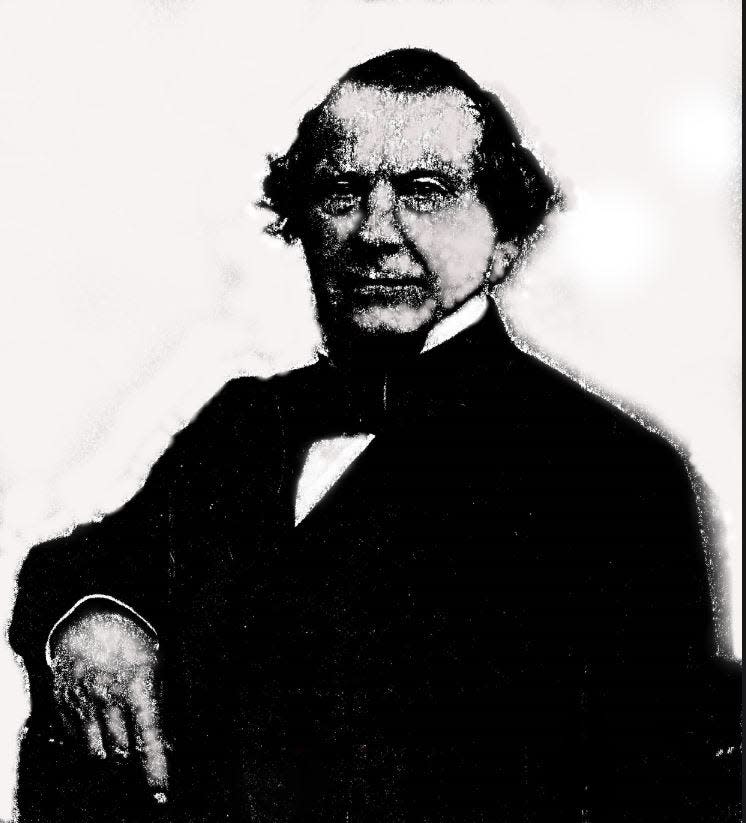
Lord was hailed as highly efficient, and remained as Chief Engineer until retiring in 1864. Lord became one of the first members of the 1st Presbyterian Church in Honesdale. He was named a trustee in 1832, and was very liberal in his support. His first wife was very active at the church.
"He was a man of uncommon mental and physical vigor," his church history published in 1906 stated. Lord was recalled as having a clean analytical mind, and was a "charming conversationalist." As canal company engineer, "many millions of dollars passed through his hands" ever showing his honest character.
Lord was known for wearing silk shirts and seal skin hats. He would call upon his older brother Solomon, a tailor, to produce nice clothing for him.
Active in community
He was very involved in community improvements. In 1849 he was on the committee taking subscriptions for the Indian Orchard and Lackawaxen Turnpike Company. This turnpike would follow the general route of Route 6 through the village soon to be renamed as Hawley, and reach the village of Lackawaxen on the Delaware River.
In 1850 he was named a commissioner of a board establishing the Honesdale Water Company. Fresh and pure water was to be supplied to the town from neighboring springs.
In December 1851 he was elected as president of the Honesdale Literary Institute, Honesdale's first public library and a venue for guest lecturers. The Institute was held in Cornell's Hall, which was near Lord's residence. The Hall burned down December 3, 1855.
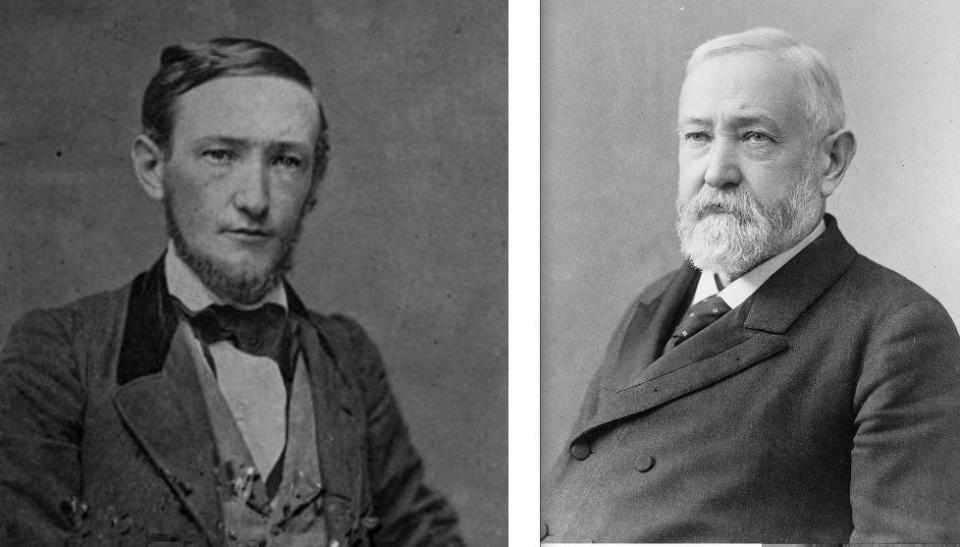
Lord posted a thank you notice in the Wayne County Herald for the citizens who successfully kept the fire from his home, and extended his sympathy to those who lost their building. A well pump was used to wet down the house, which has been scorched in the neighborhood inferno.
He also was president of the Honesdale Female Seminary in the 1840's, a trustee of the Honesdale Academy on Church Street and a trustee of the University of Northern Pennsylvania, in Bethany.
Lord was a major benefactor to the Jewish congregation in Honesdale, which was established in 1849. In March of 1956 he persuaded the D&H Canal Company to donate a building lot, 39 by 150 feet on Court Street, to erect a synagogue. He also donated the money to build the structure with the stipulation that a belfry and spire be attached to keep with the tradition of other houses of worship (churches) in the borough. The synagogue remains as the home of Temple Beth Israel to this day.
LOCAL HISTORY: Reinhard Warg: Family of shoe merchants
On January 4, 1832, Lord was wed to his first wife, Mary Ann Garrett, at the Presbyterian Church. She was born in 1809 and was a sister to Solomon Lord's wife.
They had nine children, Anna (1832-1916); George H. (died as an infant in 1835); Russell F. (1837-1899); James H. (1840-1896); George H. (1842-1844); Charlotte E. (1845-1847) and Alfred G. (died as an infant in 1847). Only three survived to adulthood.
His first wife died in 1847 from complications in giving birth to Alfred, nine days earlier.
Lord later remarried, to Elizabeth Scott; their daughter Mary would become the second wife of President Harrison. This will be discussed further in a moment.
Home on Main Street
A fine sketch of the elder Russell Lord's noble Greek Revival mansion is preserved on the margin of the large-scale 1851 map of Honesdale, Pa., which has drawings of several notable buildings of that era, most which no longer stand.
The Lord house stood at the corner of Front and Chestnut Streets- soon to be renamed as Main and Eighth. The large house, surrounded by lawn landscaped with trees and what may have been an iron fence, occupied the same corner where today stands the Jadwin Building, where stood a succession of three well-known pharmacies over the span of at least 140 years. Jadwin Pharmacy was built on the premises in 1869, after Lord's death.
The 1860 census lists a real estate value for the property at $20,000, enormous for the time (figuring for inflation it would be worth about $669,754 today). His personal estate value was listed at $30,000 ($1,004,631).
His home was across the street from the D&H Canal Company offices where he worked- which for over the last 100 years has been the Wayne County Historical Society Museum.
Benjamin Harrison's wives
The betrothal of ex-President Benjamin Harrison to Mrs. Mary Dimmick in January 1896 naturally was big news in Mary's hometown and made news all over the land. Her aunt Caroline (Carrie) had been Harrison's First Lady while in office.
Caroline Scott Harrison
John Neal was the cashier at the Honesdale Bank which had only recently opened in 1836 (later known as Honesdale National Bank). He and his wife Anna had two daughters, Anna (who wed Russell Lord's brother John) and Mary, who was married to Dr. John Witherspoon Scott, a Presbyterian minister of Beaver County, Pa. who later was a minister at Pleasant Mount, Wayne County and college professor in Ohio.
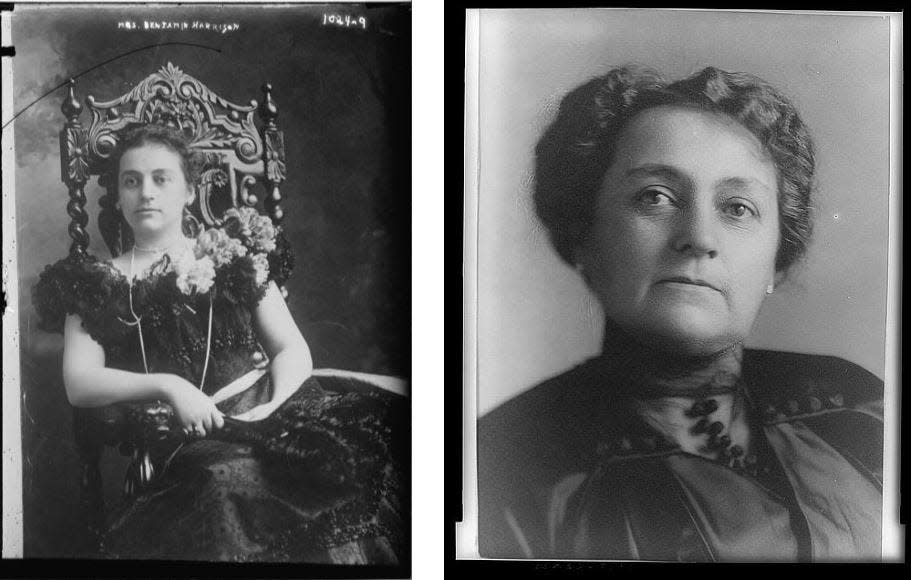
The Scotts had two daughters, Elizabeth (Lizzie) and Caroline (Carrie). The Scott sisters, who lived in Ohio would travel to Honesdale to stay with their aunt, Mrs. John Lord. John Lord's house is shown on an 1860 Honesdale map on Church Street, two doors up from Eighth Street and what is today a parking area for Highlights for Children.
Carrie, the younger sister, had met Benjamin Harrison at the college near Cincinnati where her father, Dr. Scott, was teaching. Harrison was a freshman.
In 1853, Benjamin Harrison, who was now a young lawyer from Ohio, visited Honesdale to conclude his courtship with Miss Carrie who was visiting her relations here. Russell and Elizabeth Lord host a party at their house in honor of Carrie and Benjamin.
Carrie Scott and Benjamin Harrison did not marry until October 20, 1853, to give time him to finish law school and for her to get her degree in music. They lived at Indianapolis. Harrison served in the Civil War, rising to Brigadier General.
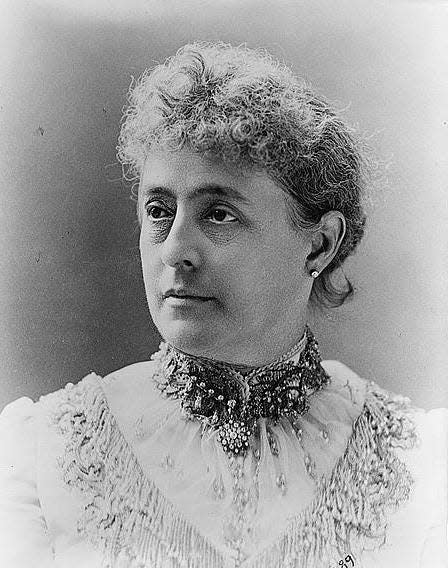
In 1888 he was elected as President of the United States. As First Lady, Caroline Harrison was noted for her elegant White House receptions and dinners. Among her initiatives, she had the White House wired for electric lights in 1889, and the same year started the annual tradition of having a White House Christmas tree.
She contracted tuberculosis in 1891, from which she died on October 25, 1892 at the age of 60. She and the President had two children, Russell Harrison and Mary Harrison.
Russell Lord's daughter Mary
After leaving office, in 1896 the former President Harrison married his late wife's niece and former secretary, Mary Scott Dimmick, a widow.
The Wayne County Herald (in the January 23, 1896 edition) commented about Russell F. Lord marrying again: "Carrie's sister Lizzie was a remarkably attractive young lady, highly accomplished, charming in person, with a lovely voice, and manners that captivated all with whom she came in contact. The ladies in the households of the brothers Lord, living but a block apart, were constantly passing back and forth, and it is not to wondered at, even if there were considerable disparity in their ages, that the lonely engineer [Russell F. Lord, Sr., being a widow] sought and obtained her hand in marriage."
Russell F. Lord, Sr. is thought to have made his acquaintance with the sisters on their visits to Honesdale, falling in love with Lizzie. He was 26 years her senior. They were engaged in 1848, and on January 29, 1849, they were married at Mount Pleasant, Ohio.
Mrs. Lord had an artistic flair and entered items in various county fairs. She was on the Paintings and Drawings Committee judging entries in the 1862 fair, the first of the ongoing Wayne County Fair held north of Honesdale.
In June, 1865 following the conclusion of the American Civil War, a group of women formed The Ladies' Solders' Monumental Association for the purpose of raising funds to have a monument and fence erected in Central Park in memory of the 383 Union soldiers from Wayne County who died in the war. A news article listing the Association members includes Mrs. Russell F. Lord. It isn't clear if this Mrs. Lord was Mary's mother, or wife of her stepbrother Russell F. Lord, Jr. The monument was not dedicated until 1869.
Russell F. and Lizzie Lord had three children, Walter, Elizabeth and Mary Lord.
Their son Walter Scott Lord (1851-1884), at the age of only 13 bought a small newspaper outfit and began publishing at Honesdale a monthly paper entitled, Young America. The Herald said he was the youngest editor in the United States. He became a civil engineer for the D&H. He never married. Walter was 33 when he died after a lengthy illness.
Their second child Elizabeth (1852-1940), became the wife of Lieut. John F. Parker. U.S. Navy. Later, her husband was promoted to Captain and served as the Second Governor of American Samoa in 1908-1910. He was stationed in Manila at the time of the Spanish–American War. While President Benjamin Harrison was in office, Capt. Parker served as an aid. He died of Bright's Disease in 1911. Mrs. Parker died in 1940.
Mary Scott Lord was born April 30, 1858 at the Lord mansion in Honesdale. She was educated mainly by private tutors.
Her father Russell F. Lord, Sr. died at home on July 7, 1867.
Shortly afterward she accompanied her mother to Indianapolis, where they remained for some time in the home of Benjamin Harrison, who was Mary's brother-in-law.
They settled in Springfield, Illinois where Mary attended a private school at the home of a sister to Mary Todd Lincoln. After a year the family moved to Princeton, New Jersey where she went to boarding school, and then a female college in Elmira, New York.
There were frequent visits back to Honesdale to the Lord homestead. On one of them on October 22, 1881, the surprise news came that Mary had eloped with Walter E. Dimmick and were married the same afternoon in Albany, NY. The Herald reported that all was forgiven as it was clear the young couple were in love and well suited for each other.
Dimmick was the first son of attorney Samuel Dimmick of Honesdale, who had become Attorney General of Pennsylvania. Young Walter was also a lawyer and was practicing in New York City when he died of typhoid fever January 16, 1882. They had been married only three months.
Helped at the White House
While Harrison was President, he asked Mary Scott Lord Dimmick to come to the White House and help her aunt, the First Lady, in discharging social functions at the White House. She accepted. Mrs. Dimmick remained in charge once her aunt had died in 1892.
The Herald suggested that if President Harrison would be given a second term, Mary would be well suited to fill the position of First Lady.
Newspapers nationwide were rife with gossip about Harrison and Dimmick's relationship. The New York Tribune reported that the President was touched by Mary's tender care of his wife in her illness, and a warmer friendship had developed between the two. They shared the sorrow of Carrie's passing.
The loss of his wife came the same year he was running for a second term. Harrison, a Republican, lost the election to Grover Cleveland, who would now return to the White House having lost to Harrison in 1888.
Harrison returned to his home in Indianapolis, where according to the press he was lonely and wanted to marry again.
Married former President
Mary was 37 when she married the former president, who was 62, on April 6, 1896 at St. Thomas Protestant Episcopal Church in New York City. Harrison's grown children were so opposed to the marriage they refused to attend the wedding. The ceremony was very simple and without decorations.
The couple made their home on Delaware Street in Indianapolis. They had one daughter together, Elizabeth Harrison Walker (1897-1955). She became a lawyer and financial columnist.
They traveled to Venezuela, and to Europe. They were at the First Peace Conference at The Hague in 1899. The former president died of pneumonia at his home on March 13, 1901. After his death, Mary lived at their Indianapolis home until 1913. The house has been preserved as the Benjamin Harrison Presidential Site.
Mary was 89 when she died in New York City on January 5, 1948. She was laid to rest at the Harrison family plot in Crown Hill Cemetery, Indianapolis. She remained keenly interested in politics, attending many Republican National Conventions. Her last was in 1940 at Philadelphia where Wendell L. Willkie was nominated.
...
Main Sources:
This article originally appeared on Tri-County Independent: One of the citizens of influence in Honesdale, Pa.'s storied history was Russell F. Lord, Sr.

